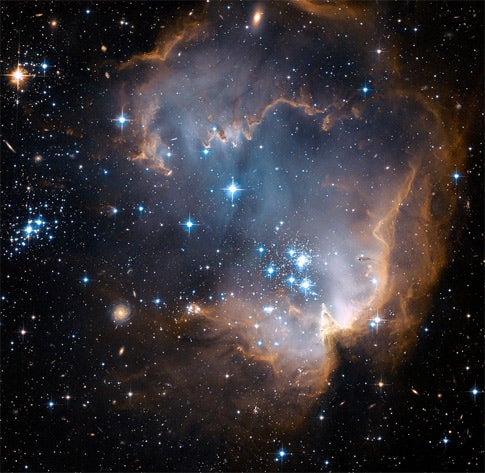Galaxies stop forming stars long before their central supermassive black holes reach their most powerful stage, according to a team of Yale University astronomers. This discovery means the black holes can’t be responsible for shutting down star formation.
Until recently, astronomers believed that active galactic nuclei (AGN) – the supermassive, energetic black holes at the centers of many young galaxies – were responsible for shutting down star formation in their host galaxies once they grew large enough. It was thought that AGN feed on the surrounding galactic material, producing enormous amounts of energy (expelled in the form of light) and heat the surrounding material so that it can no longer cool and condense into stars.
But new research shows that this shutting-down process appears to take place much earlier in the AGN’s lifetime, well before it starts shining brightly. “This high-luminosity phase, when the AGN are at their biggest and brightest and most powerful, is not the phase responsible for the shutdown of star formation,” said Kevin Schawinski, a postdoctoral associate in Yale’s astronomy department and lead author of the study.
The researchers analyzed images of 177 galaxies taken by two different space telescopes to create a comprehensive view of galaxies with AGN, including galaxies with AGN obscured by the galaxy’s dust and gas and galaxies that had an unobstructed view of the AGN from the Earth’s vantage point.
Until now, some astronomers believed they couldn’t see AGN in any galaxies that form stars because the light from the AGN is obscured by the galaxy’s gas and dust. Schawinski and his team are the first to show that there are no bright AGN at the centers of star-forming galaxies.
By subtracting the light from the AGN, the team discovered that all galaxies with bright AGN had stopped forming stars several hundred million years earlier. “The key result is the finding that there is a lack of AGN in galaxies that are currently forming stars,” said Meg Urry, head of the Yale team and director of the Yale Center for Astronomy and Astrophysics. “That tells us the AGN doesn’t turn on until long after the stars stop forming.”
“For the first time, we’ve measured a real delay between the end of star formation and the onset of a luminous AGN,” said Schawinski. As for the real culprit responsible for shutting down star formation, “It’s possible that an earlier, low-luminosity phase is responsible,” Schawinski said. “Either way, this result shows that our previous understanding of how the shutting-down process works wasn’t as simple as we thought.”










